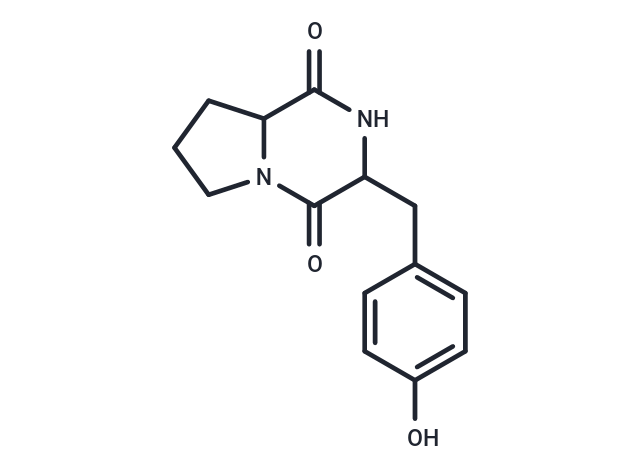Shopping Cart
Remove All Your shopping cart is currently empty
Your shopping cart is currently empty
Cyclo(Tyr-Pro) shows antibacterial activity towards several marine bacterial species, it also shows weak antagonistic activity against VEGFR2 -CD. Cyclo(Tyr-Pro) and cyclo(Pro-Val) are toxic to both suspension cells and seedlings of Pinus thunbergii, which may offer some clues to research the mechanism of pine wilt disease caused by pine wood nematode.


| Description | Cyclo(Tyr-Pro) shows antibacterial activity towards several marine bacterial species, it also shows weak antagonistic activity against VEGFR2 -CD. Cyclo(Tyr-Pro) and cyclo(Pro-Val) are toxic to both suspension cells and seedlings of Pinus thunbergii, which may offer some clues to research the mechanism of pine wilt disease caused by pine wood nematode. |
| In vitro | Various studies have shown the potentially beneficial biological activities of cyclic dipeptides and in particular, cyclo(L-tyrosyl-L-prolyl) (Cyclo(Tyr-Pro)) has shown fair antibacterial activity in vitro. This study aimed to determine if liposome encapsulation would have any significant effects on the antibacterial activity of this compound. METHODS AND RESULTS:The thin-film hydration method with extrusion was used to produce small unilamellar vesicles containing Cyclo(Tyr-Pro) that were shown to have an average encapsulation of 9.4% with a mean particle size of 160.4 nm. Minimum inhibitory concentrations tested against Staphylococcus aureus, Escherichia coli, Klebsiella pneumoniae and Bacillus subtillis were shown to be lower in liposome encapsulated Cyclo(Tyr-Pro) than for the free form, while no antimicrobial activity was noted for either encapsulated nor non-encapsulated drug against the fungus Candida albicans or two methicillin-resistant strains of Staphylococcus aureus (MRSA). A positive control of liposome encapsulated amoxicillin was shown to be extremely active against both MRSA strains. CONCLUSIONS:The results confirm that liposome encapsulation has the potential to enhance activity as well as to overcome bacterial resistance towards current antibacterial agents. |
| Molecular Weight | 260.29 |
| Formula | C14H16N2O3 |
| Cas No. | 5654-84-2 |
| Relative Density. | 1.36 g/cm3 (Predicted) |
| Storage | Powder: -20°C for 3 years | In solvent: -80°C for 1 year | Shipping with blue ice/Shipping at ambient temperature. |
| Size | Quantity | Unit Price | Amount | Operation |
|---|

Copyright © 2015-2025 TargetMol Chemicals Inc. All Rights Reserved.